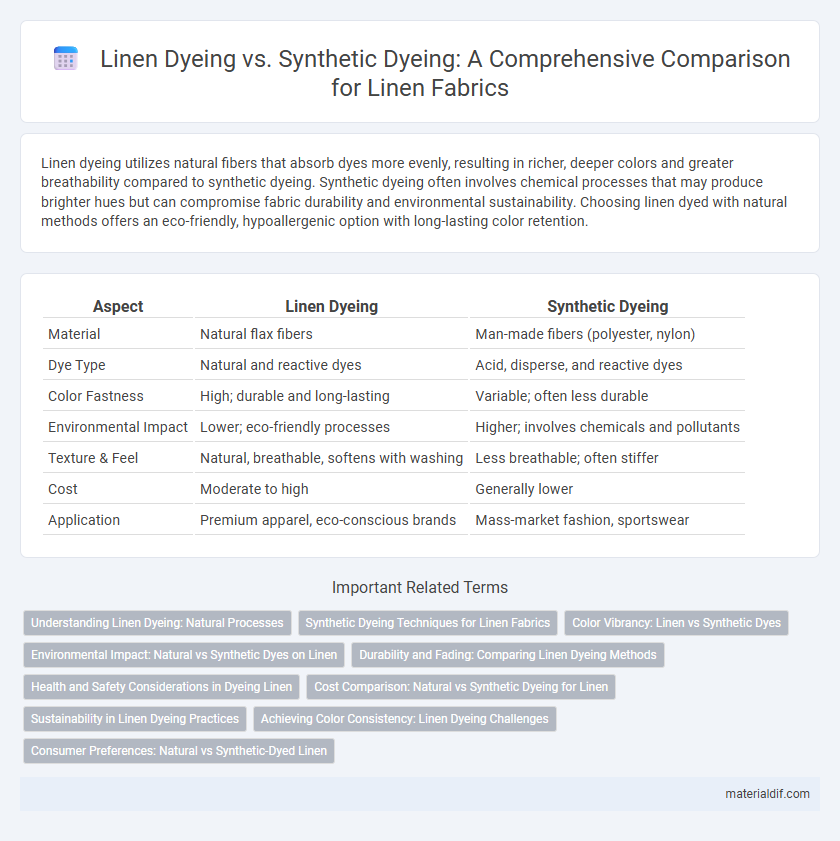Linen dyeing utilizes natural fibers that absorb dyes more evenly, resulting in richer, deeper colors and greater breathability compared to synthetic dyeing. Synthetic dyeing often involves chemical processes that may produce brighter hues but can compromise fabric durability and environmental sustainability. Choosing linen dyed with natural methods offers an eco-friendly, hypoallergenic option with long-lasting color retention.
Table of Comparison
| Aspect | Linen Dyeing | Synthetic Dyeing |
|---|---|---|
| Material | Natural flax fibers | Man-made fibers (polyester, nylon) |
| Dye Type | Natural and reactive dyes | Acid, disperse, and reactive dyes |
| Color Fastness | High; durable and long-lasting | Variable; often less durable |
| Environmental Impact | Lower; eco-friendly processes | Higher; involves chemicals and pollutants |
| Texture & Feel | Natural, breathable, softens with washing | Less breathable; often stiffer |
| Cost | Moderate to high | Generally lower |
| Application | Premium apparel, eco-conscious brands | Mass-market fashion, sportswear |
Understanding Linen Dyeing: Natural Processes
Linen dyeing relies heavily on natural fibers' ability to absorb plant-based dyes, resulting in rich, earthy tones with excellent colorfastness. The process preserves the fiber's breathability and texture, often requiring fewer chemicals compared to synthetic dyeing methods. Natural dyeing enhances linen's sustainability profile by minimizing environmental impact through biodegradable materials and reduced water pollution.
Synthetic Dyeing Techniques for Linen Fabrics
Synthetic dyeing techniques for linen fabrics utilize reactive, acid, and disperse dyes to achieve vibrant colors with excellent fastness properties. These methods enhance color uniformity and penetration by employing advanced processes such as digital printing, pad dyeing, and continuous dyeing, which optimize dye absorption and minimize environmental impact. The integration of synthetic dyes in linen treatment improves fabric durability and reduces water consumption compared to traditional natural dyeing.
Color Vibrancy: Linen vs Synthetic Dyes
Linen exhibits superior color vibrancy when dyed with natural or synthetic dyes due to its high absorbency and durable fiber structure, allowing deeper pigment penetration. Synthetic dyes, while offering a broader color range and faster fixation, can sometimes produce less radiant hues on linen compared to cotton or polyester fabrics. The unique texture and breathability of linen enhance the perception of color depth, making dye selection critical for achieving optimal vibrancy.
Environmental Impact: Natural vs Synthetic Dyes on Linen
Linen dyeing with natural dyes reduces environmental pollution by avoiding toxic chemicals and synthetic dyes that release harmful pollutants into water systems. Natural dyes used in linen processing are biodegradable and often derived from renewable plant sources, minimizing soil and water contamination. Synthetic dyes, although vibrant and cost-effective, contribute significantly to water pollution and create challenges in wastewater treatment due to their chemical complexity.
Durability and Fading: Comparing Linen Dyeing Methods
Linen dyeing using natural dyes offers superior breathability and eco-friendliness but often results in less colorfastness compared to synthetic dyes, which provide enhanced durability and resistance to fading under prolonged sunlight exposure. Synthetic dyeing processes penetrate linen fibers more uniformly, creating vibrant and long-lasting colors that withstand repeated washing and wear. However, natural dyes maintain a unique, rich patina over time, appealing to consumers valuing authenticity despite their comparatively lower durability.
Health and Safety Considerations in Dyeing Linen
Linen dyeing primarily uses natural dyes derived from plants, minimizing exposure to harmful chemicals and reducing skin irritation risks compared to synthetic dyeing, which often involves toxic substances like azo dyes linked to allergies and respiratory issues. The biodegradability of natural dyes supports safer wastewater management, while synthetic dyes can contribute to environmental pollution with hazardous effluents. Choosing linen dyed with natural processes enhances both consumer health and ecological safety by limiting chemical hazards throughout production and use.
Cost Comparison: Natural vs Synthetic Dyeing for Linen
Natural dyeing of linen often incurs higher costs due to the expensive raw materials and labor-intensive extraction processes, whereas synthetic dyeing offers lower expenses owing to mass-produced chemicals and faster application methods. Although natural dyes provide eco-friendly benefits and unique color variations, synthetic dyes remain more cost-effective for large-scale linen production. The choice between natural and synthetic dyeing ultimately hinges on budget constraints and desired environmental impact.
Sustainability in Linen Dyeing Practices
Linen dyeing prioritizes sustainability by utilizing natural dyes extracted from plants, reducing the reliance on harmful chemicals and minimizing water pollution. The biodegradable nature of linen fabric combined with eco-friendly dyeing methods significantly lowers the environmental footprint compared to synthetic dyeing, which often involves petrochemical-based dyes with toxic effluents. Sustainable linen dyeing practices also embrace water recycling and low-energy processes, promoting circularity and resource conservation in textile production.
Achieving Color Consistency: Linen Dyeing Challenges
Linen dyeing presents unique challenges in achieving color consistency due to its natural fiber composition and irregular absorption properties, leading to uneven coloration compared to synthetic fibers. The cellular structure of flax fibers causes variability in dye uptake, making it difficult to maintain uniform shades across large batches. In contrast, synthetic dyeing benefits from controlled fiber characteristics, ensuring more predictable and consistent color results.
Consumer Preferences: Natural vs Synthetic-Dyed Linen
Consumers increasingly prefer natural-dyed linen due to its eco-friendly properties, reduced chemical exposure, and unique color variations that enhance fabric authenticity. Synthetic-dyed linen, while offering vibrant and consistent colors, raises concerns about environmental impact and potential skin irritations. Market trends show a growing shift towards sustainable fashion, boosting demand for naturally dyed linen in eco-conscious consumer segments.
Linen Dyeing vs Synthetic Dyeing Infographic

 materialdif.com
materialdif.com